During the hot days of summer, shade gardens are the most happening places for those who live in the tropics, but sometimes the darkness under the trees can get downright gloomy. Tropical plants are as bright and vibrant as sunny flowerbeds, and surprisingly many will thrive in even the shadiest areas of your garden. Here are some ways to bring life to the darkest corners of your yard — whether you live in South Florida or are looking to add tropical flair in a more temperate climate.
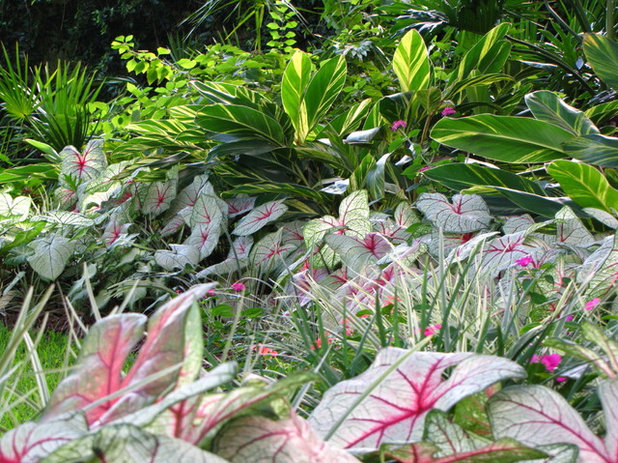 Brighten with bulbs.
Brighten with bulbs. This planting of
caladiums (
Caladium spp, USDA zones 9 to 11) and
variegated shell ginger (
Alpinia zerumbet 'Variegata') by Cynthia "Meems" Glover is an excellent example of how a seasonal planting of tropical bulbs can brighten up dark areas of the garden. Here the bulbs been allowed to mingle with other plants of finer foliage, giving the appearance of dappled sunlight in a forest clearing.
Tropical summer bulbs can still be planted in summer but must be dug up before the first frost in fall. Store clean bulbs in a dry medium, such as vermiculite, shredded paper or sphagnum moss, until planting them again after the last frost of spring. Those in the warmer zones (7 to 11) can experiment with leaving plants in the ground but should be sure to cover them with a generous layer of mulch in winter.
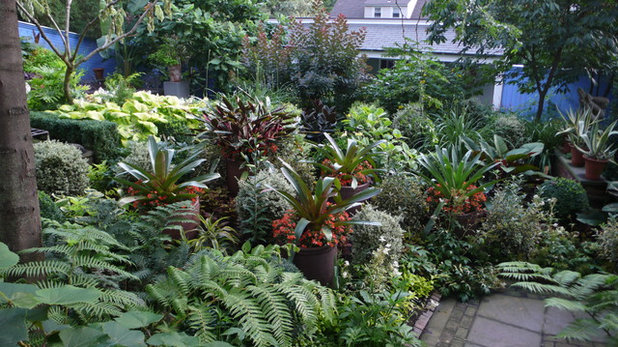 Bring houseplants outdoors.
Bring houseplants outdoors. This irresistible vignette of bromeliads (
Alcantarea imperialis, zones 9b to 11) and
tree ferns (
Cyathea cooperi, zones 9 to 11) could have been shot in Hawaii, but this photo was actually taken in Seattle. By staging tropical plants in ceramic urns in staggered heights amidst soft greenery, AHBH Landscape Architecture has set a stage than can be easily dismantled before the first frost.
This look can be easily re-created, provided you keep the leaves from getting burned by slowly moving the plants to a shady area outdoors. Houseplants appreciate the fresh rainwater and humidity that they receive in the garden, and you'll appreciate the exotic vibe that they lend to your backyard retreat.
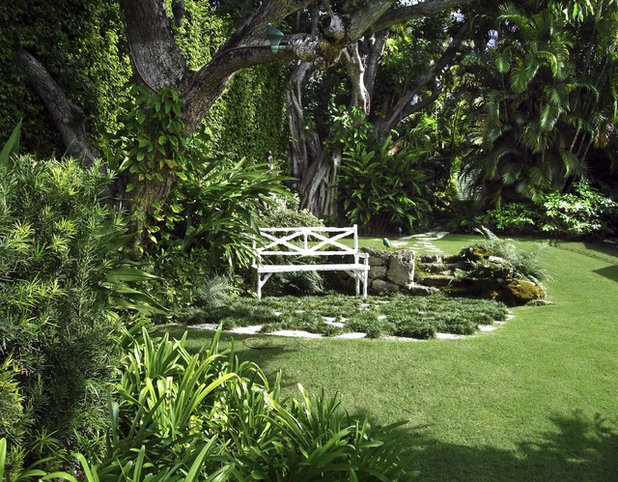
Blakely and Associates Landscape Architects, Inc.
Replace grass with shade-tolerant ground covers. Turf grasses can have a hard time growing in the shade, but low-maintenance ground covers combined with stepping stones make an excellent alternative. Their deep green and finely textured foliage also makes the perfect backdrop for bold and leafy tropical plants.
Whether you live in Florida or New York, the
mondo grass (
Ophiopogon japonicus, zones 6 to 11) in this photo makes an excellent lawn replacement for shadier spots and remains evergreen in warmer zones.
Liriope (
Liriope muscari, zones 5b to 11) and
ferns are also good choices for a finely textured ground cover.
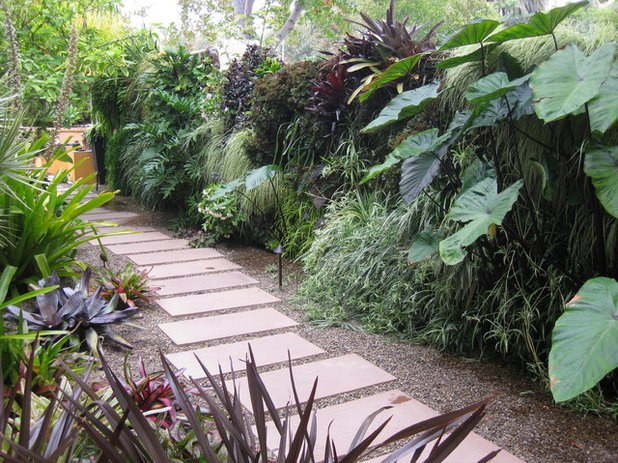
Amelia B. Lima & Associates
Make gloomy side yards enticing. Side yards are often overlooked in the garden as areas of little potential, and are relegated to storing trash bins, compost heaps and other eyesores. Side yards in the shade can look even more depressing.
To make things interesting, plant tropical bulbs like
elephant ears (
Colocasia and
Alocasia, zones 7 to 11) or winter-dormant gingers, like
shampoo ginger (
Zingiber zerumbet, zones 7b to 11), with its bright red cones held aloft by tall stalks in late summer and fall. These and other bulbs can be left in the ground or dug up in fall, depending on your climate. Out of the way to the side of the house, the tropical bulbs won't draw attention to themselves when they decline or get hit by frosts.
How to turn a side yard into a glorious garden
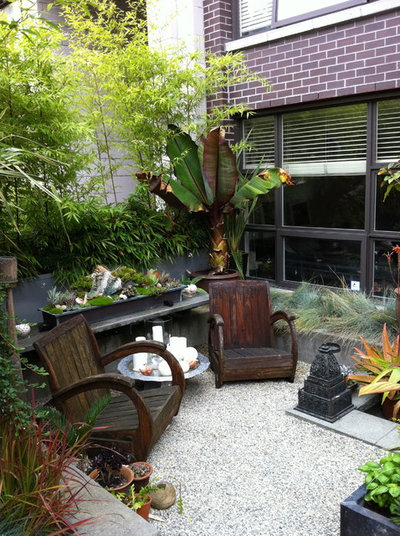
Glenna Partridge Garden Design
Use small spaces. Oftentimes it's the smallest garden spaces that are the most poorly lit, whether adjacent walls, trees or tall buildings are at fault. The upsides to cramped areas like the courtyard shown here are that they're easily tended to and often have their own protected microclimate, making them ideal for growing tropicals.
When using tropical plants in small areas, a little goes a long way. Don't add too many plants right away, since many will quickly outgrow their space and require trimming or division to keep them from making the garden seem even more snug. Start with a solid backbone of hardy evergreen shrubs and ground covers and an inviting paved area so that visitors (and yourself) can enjoy the garden. Then bring out the big guns.
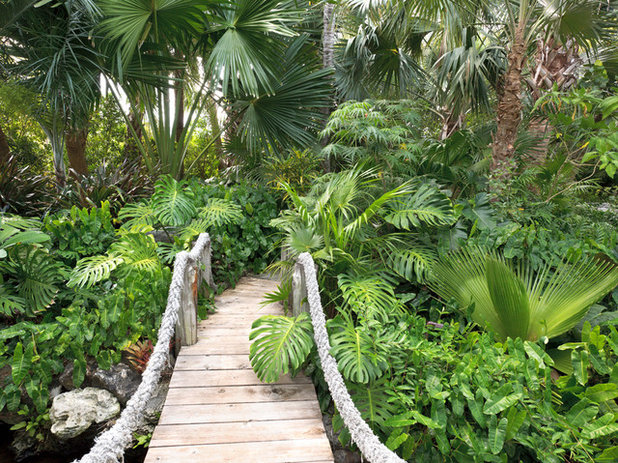
Raymond Jungles, Inc.
Use texture. Many gardeners grow tropical plants for their color, but you mustn't overlook the dramatic and architectural textures that they lend to the landscape as well. Every single texture in the photo here is provided by a tropical plant, yet gardeners outside the tropics can get the same effects by using temperate and tropical foliage plants together in the same bed.
The
philodendron (
Philodendron 'Burle-Marx', zones 10 to 11) can be swapped out with temperate plants with a similar texture, such as
hostas (
Hosta spp, zones 3 to 9), while the larger-leaved palm trees can be replaced with cold-hardy types, like
windmill palm (
Trachycarpus fortunei, zones 6b to 11) or
needle palm (
Rhapidophyllum hystrix, zones 6 to 11). Oh, and that
Swiss cheese plant (
Monstera deliciosa, zones 9b to 11) peeking over the path? Its iconic cut leaves make it worthwhile to grow in a container and take indoors for winter.
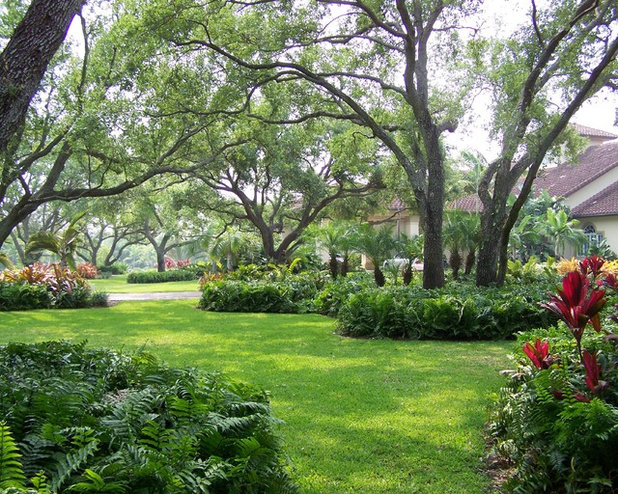
orlando comas, landscape architect.
Control your shade. There's a big difference between the gentle and airy shade provided by the
live oaks (
Quercus virginiana, zones 7 to 11) shown here and the mixed light on the side of a house that abruptly shifts between full shade and direct sun throughout the day. You can gain shade by planting new trees and let in more light by hiring an arborist to thin branches and remove any undesirable trees.
Beware of trees marketed as fast growing, as they're often too fast for their own good and plague homeowners with brittle limbs, messy seeds and invasive roots. Instead, choose trees that you wouldn't mind seeing for many years to come.





